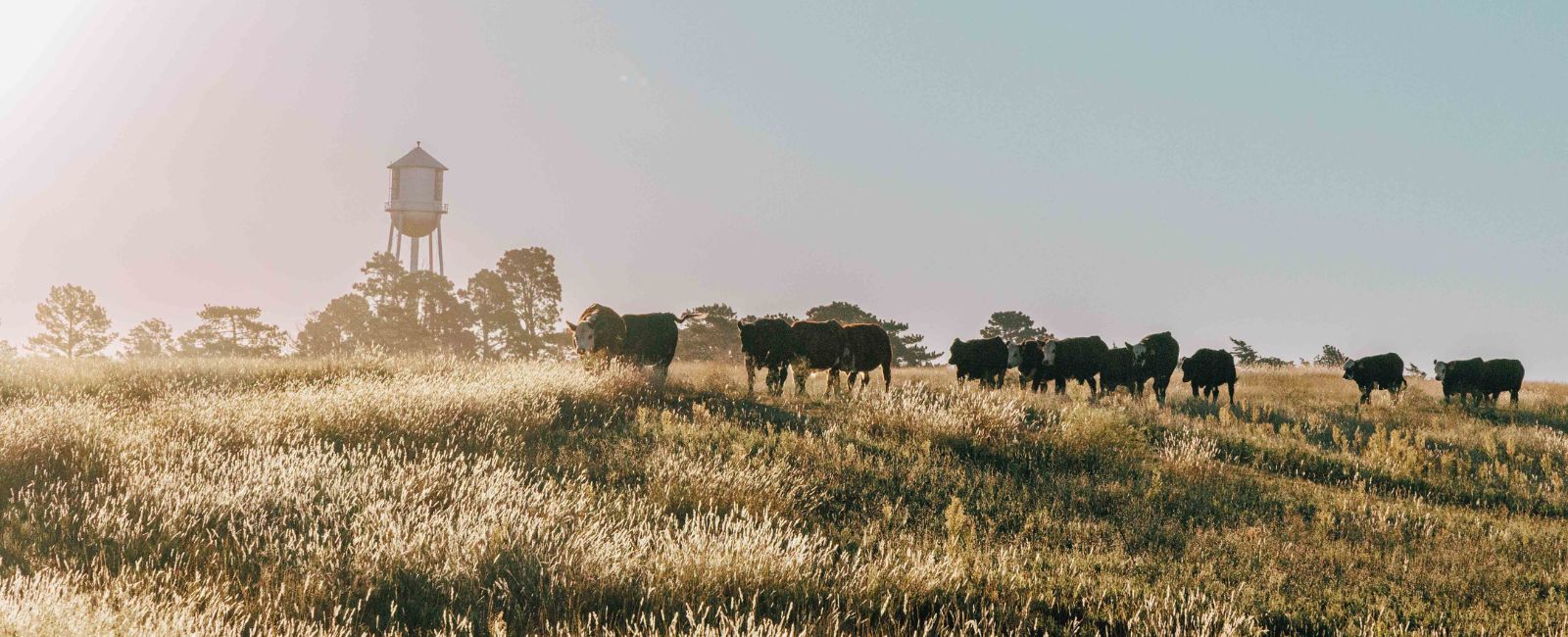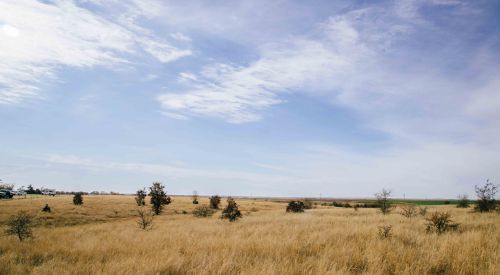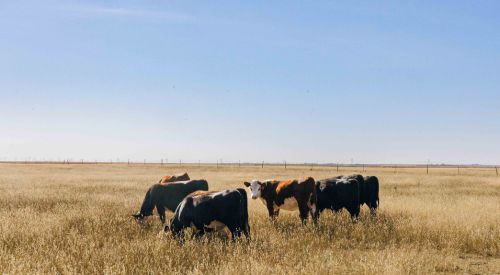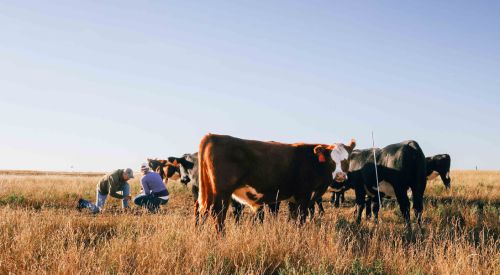
Rangeland Science
About 7 million hectares (17.5 million acres) in Kansas are rangeland and pastureland. The range research program at Hays focuses primarily on the mid- and shortgrass prairie region, or the western two-thirds of Kansas, which encompasses about 4.8 million hectares (12 million acres).
The goal of the K-State WKREC Range Science program is to develop economically-viable, forage-based, beef-production systems for both cow-calf and stocker operations. Emphasis is on efficient conversion of forages to animal product and the assessment of range response and system sustainability. Energy and protein supplements, and planted forages that complement native range nutritionally, are studied in a systems context. The goal is to maintain diet quantity and quality at a level sufficient to meet cattle maintenance and growth requirements during various production phases and to extend the length of the grazing season. Cattle management alternatives such as varying stocking density and season of use, and land management inputs such as fertilizers, pesticides, and burning, are tested to determine their effect on animal response and range improvement.
Meet Our Research and Extension Specialists
Decision making for grass turnout in Western Kansas.
Keith Harmoney, K-State range scientist at Hays, has studied historical data from range research at the experiment station including droughts in the 1930s and 1950s as well as more recent droughts and will use all of this to share his thoughts on planning and decision making for this spring.
Current Research Projects
Title: Herbicide Activity on Old World Bluestems
Authors: Keith Harmoney
Topic: Old World bluestems, including yellow and Caucasian bluestem, threaten Kansas rangelands by reducing species diversity and displacing native grasses. This study evaluates alternative herbicides for controlling these invasive grasses, building on previous findings with glyphosate and imazapyr.
Title: Interseeding Sorghum-Sudangrass into Perennial Cool-Season Western Wheatgrass Pasture
Authors: Keith Harmoney and John Guretzky
Topic: Rapid conversion of pastureland to cropland on the Great Plains has reduced pasture acreage and beef cow numbers. This study explores introducing warm-season annual grasses into cool-season pastures to boost mid-summer forage production and increase overall land productivity.
Title: Effect of Feeding Interval on Finishing Performance of Beef Steers
Authors: Chance Fiehler, Justin Waggoner, Keith R. Harmoney, K.C. Olson and John R. Jaeger
Topic: Consistent feeding times have long been considered essential for optimal beef cattle performance, with guidelines dating back to 1905 emphasizing the importance of regularity. This study explores how stable versus variable once-daily feed delivery impacts beef steer finishing performance, building on limited research in this area.
Title: An Efficient Stocking Strategy for Grazing Replacement Heifers
Authors: Keith R. Harmoney and John R. Jaeger
Topic: Producers may be looking to increase production efficiency on a shrinking forage land base. The use of intensive early stocking (IES) is one of the most efficient stocking strategies to produce beef on rangeland acres. The IES strategy has been widely used in eastern Kansas and is capable of increasing beef production by 30–40% compared to continuous season long stocking (SLS).
Title: Using Modified Intensive Early Stocking for Cow/Calf Production
Authors: Keith R. Harmoney and John R. Jaeger
Topic: A similar modified IES (MIES) system has increased production efficiency of stocker animals on western Kansas rangelands. Perennial grassland acres for cattle production, as well as cattle numbers, are declining. Using management practices that mimic the MIES system to increase beef cattle stocking density for breeding herds may allow producers to maintain or increase cow numbers for beef production on fewer perennial grassland resources. The objective of this project is to compare cow and calf growth and performance in traditional continuous season-long stocking (SLS) and MIES beef production systems. The objective of this research was to examine the effect of exercise four times daily for the first 14 days after arrival on incidence of BRD and animal growth and performance.
Title: Effect of Exercise on Health and Performance by Long-Haul, High-Stress Steers During the Receiving Period
Authors: John R. Jaeger, Justin W. Waggoner, Keith R. Harmoney, and Quentin Rupp
Topic: Morbidity and mortality associated with the bovine respiratory disease (BRD) complex continue to be a significant challenge to the United States beef industry. Stress associated with maternal separation, environment change, transportation, diet changes, and commingling are common to beef industry marketing channels and have been linked to depressed growth and health of recently weaned calves.
Title: Saline Experimental Range Dormant Season Wildfire: Short-Term Effect on Forage Production and Plant Composition
Author: Keith R. Harmoney
Topic: Rangeland wildfires in the southern plains may occur any time of year, but the low humidity, increasing temperatures, and dry and abundant fuel load of late winter and early spring can result in greater wildfire occurrence and severity. Information collected at the Kansas State University Agricultural Research Center–Hays shows that forage production was significantly reduced for two years following a recent wildfire event.
Old World Bluestem Seedling Emergence and Vegetative Cover Following Glyphosate Treatment
Old world bluestems are difficult to control in native pasture. Treating a pasture area in consecutive years can significantly reduce mature OWB plant cover, but new OWB seedlings will also likely emerge over time.
Control of Individual Honey Locust Trees in Grazed Pasture
Honey locust trees are native to eastern Kansas, but the introduction of honey locust into western shelterbelts and the lack of a consistent pasture burning regimen has allowed new seedlings to emerge and establish stands in western Kansas pastures. Some individual locust tree herbicide application methods provide excellent control of honey locust in grazed pasture.
Interseeding Warm-Season Annual Grasses into Perennial Cool-Season Western Wheatgrass Pasture
Rangeland and pasture acres are slowly disappearing due to urbanization and tillage for growing crops. In order to retain cow numbers on a shrinking pasture acreage, increased dry matter production per acre from current pasture is needed to replace the dry matter from lost pasture acres.
Ropewick Application to Control Old World Bluestems
In pastures with low growing native vegetation, ropewick herbicide application may allow limited control of OWB without damaging native plants.
Comparing Season-Long Stocking and a Modified Intensive Early Stocking Strategy for Western Kansas
To ensure management flexibility during years of low precipitation, producers should include in their grazing program young stocker animals that can be marketed at any time to enable them to destock and restock rangelands without liquidating their main breeding herd. A modified intensive-early stocking system resulted in greater beef production and greater net returns per acre with less income risk compared to a continuous season-long stocking system.
Using Modified Intensive Early Stocking for Grazing Replacement Heifers
Modified intensive-early stocking allows greater beef production per acre on shortgrass vegetation compared to typical continuous stocking using stocker steers. This same stocking system using breeding stock could be beneficial to producers raising replacement heifers.
Can Modified Intensive Early Stocking Be Used in Cow/Calf Production?
Modified intensive-early stocking allows greater beef production per acre on shortgrass vegetation compared to typical continuous stocking using stocker steers. However, western Kansas rangelands are dominated by cow/calf production rather than stocker steer production. Cow/calf pairs may be used in modified intensive-early stocking systems by weaning calves earlier in the season.
Grazing Wheat Did Not Reduce Beef Cow Pregnancy
Grazing seeded cool-season cereal grasses can extend the typical native rangeland grazing season and provide a high-quality diet for lactating cows in the early spring. But, lush forage high in protein may decrease fertility because of high blood urea nitrogen content. Beef cows grazing wheat before and during the breeding season showed no signs of lower fertility in this experiment.
Grazing system that has benefitted steers can boost cow-calf operations too
Researchers at the Kansas State University Agricultural Research Center in Hays have found that a grazing system shown to be beneficial for the performance of steers also has great potential for cow-calf producers.
Clark County farmers continue recovery from historic fire
Range scientist Keith Harmoney from the Agricultural Research Center meet with farmers impacted by the Starbuck Fire that consumed approximately 660,000 acres last year. Harmoney discussed grass stand with local farmers.
Other Research Projects
- Growth Responses of Perennial Cool-Season Grasses Grazed Intermittently (PDF)
- Grazing Persistence of Perennial Cool-Season Grasses (PDF)
- Control and Utilization of Japanese Brome (PDF)
- Modified Intensive-Early Stocking on Shortgrass Rangeland (PDF)
- Old World Bluestem (PDF)
The above stated research has been partially sponsored by the J. H. Baker Trust.
K-State researchers embark on study to preserve prairie health
Kansas State University researchers have launched a study to improve the effectiveness of controls on woody plants, an effort they say will help to preserve the health of native grasslands in Kansas.


